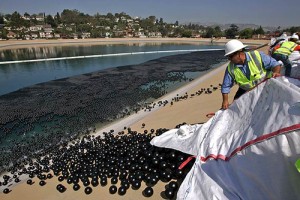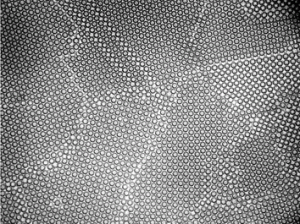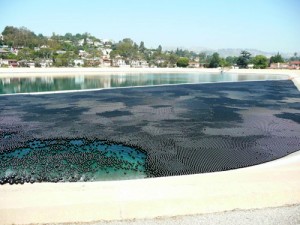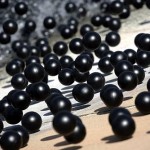For the Materials Scientist, a very interesting event happened on Monday 6/9/08. The Los Angeles department of water and power inadvertantly may have created the largest Materials Science demo of crystal stacking, defects, and boundaries when they placed 400,000 balls onto the surface of the Ivan Hoe Reservoir. [Read the original news release (including video) by the LA Times (images from LA Times) or the blog post at Design Verb where I found out about it.]

The balls are being placed on the surface of the lake in order to prevent the formation of various forms of bromates [wikipedia]. The bromates are forming due to the presence of both chlorine and bromine in the water coupled with the presence of sunlight. Local public officials hope that the balls will help block sunlight from the lake-water and prevent the bromate formation. [Let's hope that heat doesn't form it either- those balls are going to get really hot with the sun blaring down on them!]
The balls on the surface of the lake is almost exactly like a model often used as a class-room demo called a “Bubble Raft” [wikipedia]. The model describes in 2 dimensions (usually) the concepts of crystallites (polycrystals), grain boundaries, and dislocations. The more common demonstration is table-top consisting of a large number of bubbles on the surface of a thick liquid like glycerin.

There are even published articles utilizing this approach as a model system for indentation measurements etc. Other common places to see this phenomonon is when you get a pop from the machine (clear-plastic bottle), you may see bubbles form various areas of ordered stacking. Of course, the structure of the pop-bottle bubble raft is quite complex- stacking faults and dislocations abound.
If you look closely at the above image, you’ll notice that there are a number of areas where the balls are all stacked nicely in 2D, and then a little further away, a different orientation of stacking… when these two meet, there’s a “grain boundary”[wikipedia]. In fact, this is exactly what a polished and etched sample of polycrystalline metal looks like in a reflected light microscope. Of course, in a sample like that, you can’t see the atoms at all, but just regions of different reflectivity. (See how the lightness/darkness of the “crystallites” are different?) Little lines in the microscope show the boundaries (often acid etching is required to see them). Of course, if you have a transmission electron microscope (TEM), for instance, you actually *can* see stacks of atoms and grain-boundaries! [There is a world-class Aberration Correction TEM available at the FS-MRL where I currently do research. Hopefully I'll be able to use it to get some excellent images to share.]
Frequently in Science we find beauty in the things around us. Along with all this beauty is some natural function or rule, often unique and interesting. All you have to do is keep your eyes open, walk a bit slower, and enjoy the walk (or bounce as the case may be)!



